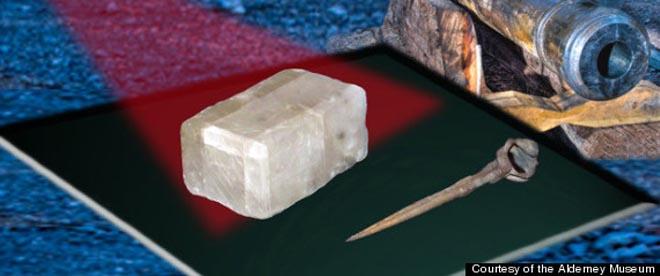Curious stone shown to be mythical navigation tool - the sunstone
by Nancy Knudsen on 14 Apr 2013

Milky white stone discovered, now shown to be the mythical sunstone SW
The milky white stone found in the remains of a ship dispatched to France in 1592 by Queen Elizabeth I, which foundered off the Island of Alderney in the English Channel, IS a sunstone, researchers say, a near-mythical navigation tool used by Viking sailors
In a theory first aired 45 years ago, sunstones were clear crystals which were used as navigation tools by the great Viking mariners to navigate their way during the Viking heyday of 900-1200AD, a long time before the magnetic compass was introduced to Europe in the 13h century. Sunstones assumes near-mythical status as the theory couldn't be proven.
The discovered stone has been confirmed to be made of Iceland spar, a transparent, naturally-occurring calcite crystal that polarises light and can get a bearing on the sun
British and French scientists have long argued that the find could be a sunstone - a device that fractures the light, enabling seafarers to locate the sun even when it is behind clouds or has dipped below the horizon.
But there is only a sketchy reference in ancient Norse literature to a 'solarsteinn,' which means the idea has remained frustratingly without solid proof. The sunstone is a type of mineral attested in several 13th–14th century written sources in Iceland, one of which describes its use to locate the sun in a completely overcast sky. Sunstones are also mentioned in the inventories of several churches and one monastery in 14th–15th century Iceland.
The description in 'Rauðúlfs þáttr' of the use of the sunstone is as follows:
The weather was thick and snowy as Sigurður had predicted. Then the king summoned Sigurður and Dagur (Rauðúlfur's sons) to him. The king made people look out and they could nowhere see a clear sky. Then he asked Sigurður to tell where the sun was at that time. He gave a clear assertion. Then the king made them fetch the solar stone and held it up and saw where light radiated from the stone and thus directly verified Sigurður’ s prediction.
However, in a study published recently in the British journal Proceedings of the Royal Society A, investigators carried out a chemical analysis on a tiny sample, using a device called a spectrometer, which confirmed that the stone was a calcite.
The original stone is about the size of a small bar of soap whose edges have been trimmed at an angle.
It is milky white in appearance, and not transparent, but the new experiments show that this is surface discolouration, caused by centuries of immersion in sea water and abrasion by sand, the study said.
Using a transparent crystal similar to the original, the scientists were able to follow the track of the setting sun in poor light, with an accuracy of one degree. In a second experiment, they were able to locate the sun for 40 minutes after sunset.
Other factors provide evidence that this is a sunstone, according to the investigation, led by Guy Ropars of the University of Rennes, in France's western region of Brittany.
The crystal was found in the wreckage alongside a pair of navigation dividers.
If you want to link to this article then please use this URL: www.sail-world.com/108407